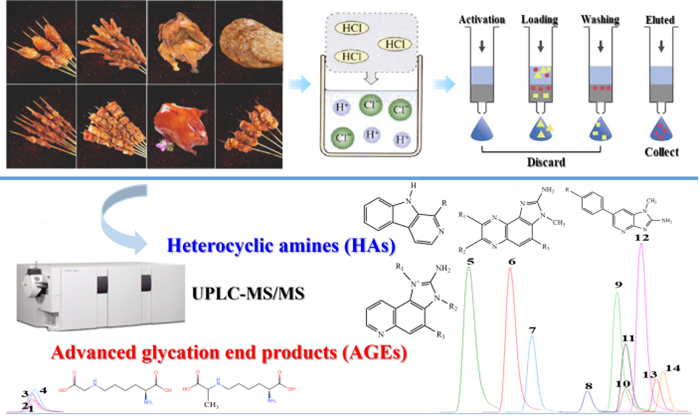A method for simultaneous quantitative detection of advanced glycation end products and heterocyclic amines in roast/grilled meat
Recently, the Meat Science and Nutrition Innovation team of Institute of Food Science and Technology of CAAS (IFST-CAAS) developed a method for the efficient separation and simultaneous quantitative detection of advanced glycation end products (AGEs) and heterocyclic amines (HAs) in roast/grilled meat, which published in Food Chemistry (JCR, Q1, IF=8.8). Mingyu Li, a 2022 joint Ph.D. student at the IFST-CAAS, is the first author, and Dequan Zhang is the corresponding author of this paper. The research was supported by Shandong Province Key R&D Program (Action Plan for Revitalizing Science and Technology Innovation and Revitalization of Rural Areas) [Grant No. 2022TZXD0021], and Taishan Industrial Experts Programme of China.
AGEs and HAs are harmful Maillard reaction products, and thermal processing of meat products appears to produce and accumulate both simultaneously. Single monitoring alone is time consuming, costly and no longer sufficient to meet public demand for food safety, while simultaneous selective, rapid and reproducible determination of the these harmful Maillard reaction products is important for analytical applications and diagnostic studies.
In this study, the pre-treatment method, chromatographic parameters and mass spectrometry parameters of AGEs and HAs detection samples in roast/grilled meat were optimized, and a detection method with high responsiveness, good separation effect and simultaneous determination of AGEs and HAs was established. The results showed that the ultra-performance liquid chromatography coupled to tandem mass spectrometry (UPLC-MS/MS) using dynamic multiple reaction monitoring (D-MRM) to achieve reasonably good separation and high response for the 11 target analytes within 8 min. The calibration curves showed good linearity over a wide range (10 - 200 ng/mL) between concentration and peak areas with correlation coefficients (R2) > 0.99. The LODs and LOQs range from 0.01 - 0.27 ng/mL and 0.04 - 0.91 ng/mL, respectively. The recovery, precision, stability and matrix effect were generally acceptable.
The above research provides a new approach to monitoring AGEs and HAs in food, which in turn helps to comprehensively assess roast/grilled meat quality and health risks, and facilitates the development of research into the interactions between multiple hazards.

Flow chart for the simultaneous determination of advanced glycation end products and heterocyclic amines in roast/grilled meat by UPLC-MS/MS
Original link:https://doi.org/10.1016/j.foodchem.2024.138930
-
 May 11, 2024WRI Deepens Agricultural Technology Cooperation with Agricultural Research Institutions in Uzbekistan
May 11, 2024WRI Deepens Agricultural Technology Cooperation with Agricultural Research Institutions in Uzbekistan -
 Apr 28, 2024CAAS President Meets President of Murdoch University
Apr 28, 2024CAAS President Meets President of Murdoch University -
 Apr 18, 2024Opening Ceremony of the Training Workshop on Wheat Head Scab Resistance Breeding and Pest Control in Africa Held in CAAS
Apr 18, 2024Opening Ceremony of the Training Workshop on Wheat Head Scab Resistance Breeding and Pest Control in Africa Held in CAAS -
 Apr 03, 2024IPPCAAS Co-organized the Training Workshop on Management and Application of Biopesticides in Nepal
Apr 03, 2024IPPCAAS Co-organized the Training Workshop on Management and Application of Biopesticides in Nepal -
 Mar 28, 2024Delegation from the School of Agriculture and Food Science of University College Dublin, Ireland Visit to IAS, CAAS
Mar 28, 2024Delegation from the School of Agriculture and Food Science of University College Dublin, Ireland Visit to IAS, CAAS
